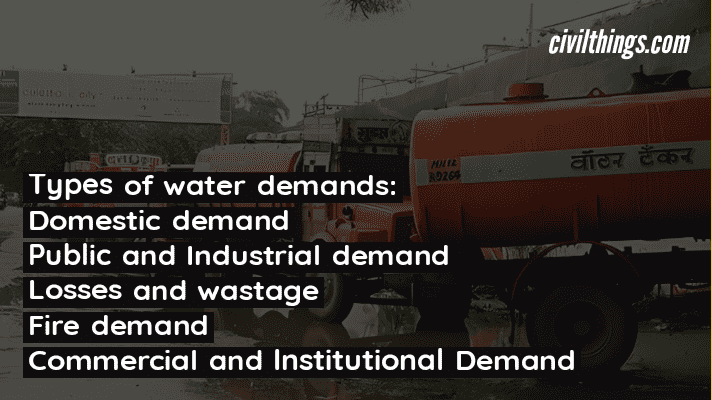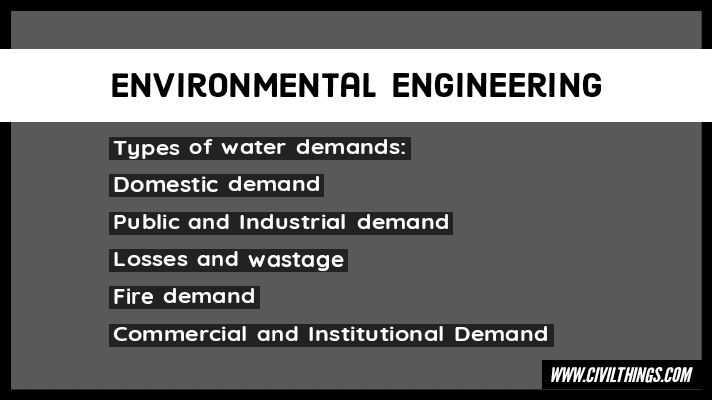Water Demand, it is a requirement of water by users. It represents the quantity of water that individuals, communities, industries, and other entities seek to utilize within a specific timeframe, typically measured in liters, gallons, or cubic meters.
Water demand is influenced by a wide range of factors, including population size, economic activities, climate conditions, and cultural practices. The water demands of different sectors can vary significantly.
Table of Contents

Demands of Water
Water is the principal raw material for food production and for many other uses outside the home and on the farm.
Water has a significant impact on our daily lives beyond its direct use for consumption at households and farms, manifesting in numerous indirect ways.
The use of water by plants, animals, and us is universal. It plays an important role in the manufacture of essential commodities, the generation of electric power, recreation, transportation, and industrial activities.
Thus, water can be considered as the most important raw material of civilization because without water, man can not live and industry can not operate. Hence, it is necessary to calculate the various demands of water.
The following are the various types of water demands:
|
Domestic Water Demand:
According to IS 1172-1983, the minimum requirement of water for domestic consumption is 135 liters. This includes the water required for domestic purposes such as drinking, bathing, lawn sprinkling, sanitary purposes, air conditioning, etc.
The total domestic demand amounts to approximately 50% of the total water demand.
The break up of 135 liters/capita/day may approximately be taken as follows:
| Sr. No. | Use | Consumption/capita/day |
| 1.
2. 3. 4. 5. 6. 7. | Bathing
Flushing of latrines etc. Washing of clothes Washing of utensils Washing and cleaning the house Cooking Drinking | 55 Litres
30 Litres 20 Litres 10 Litres 10 Litres 5 Litres 5 Litres |
| Total | 135 Litres |
Public and Industrial Needs:
Public Needs:
The quantity of water required for public utility purposes such as washing and sprinkling on roads, cleaning sewers, and watering public parks, gardens, public fountains, swimming pools, etc. comes under public demand.
When designing water infrastructure for a city, it is common practice to allocate 5% of the total water consumption specifically for meeting the needs of the public.
The requirements of water for public purposes shall be taken as given in Table.
Table: Water Requirements for a public purpose
| Sr. No. | Purpose | Water Requirements |
| 1.
2. 3. 4. | Public Parks
Street washing Sewer cleaning Roadside trees | 1.4 lit/m2/day
1.0-1.5 lit/m2/day 4.5 lit/head/day 28,150 lit/km/day |
Industrial Needs:
For small industrial needs within the town, the water required is included in the per capita rate itself; large industries may use their source of water.
However, if water is required from the public water supply, then the water required depends on the type and size of the industry.
The requirement also depends on factors such as the cost of water, and availability of water.
Hence, the demand for each industry has to be examined individually.
However, it accounts for 10 to 20% of the total demand for fully developed cities depending upon the intensity of industrialization.
The water requirements for a few industries are given below:
Table: Water requirements of the industry
| Sr. No. | Industry | Production unit | Consumption in kilo liter per production unit |
| 1.
2. 3. 4. 5. | Automobile
Fertiliser Paper Sugar Textile | Vehicle
Tonne Tonne Tonne Quintal | 40 kilo lit/vehicle
80 to 200 kilo lit/tonne 200 to 400 kilo lit/tonne 10 to 100 kilo lit/tonne 80 to 140 kilo lit/tonne |
Losses and Wastage:
The water which goes in the distribution pipes does not reach up to the consumers fully.
Some part of this quantity is wasted in the pipelines due to defective pipe joints, cracked and broken pipes, faulty fittings, and valves.
Also sometimes, consumers keep their taps or public taps open even when they are not used and allow continuous wastage of water.
Loss of water in a waterworks is due to:
(1) Unauthorized water connection.
(2) Motor and pump slippage
(3) Bad plumbing.
(4) Leakages.
The loss due to unauthorized connections may be reduced by surveying the areas and detecting them.
Even in a fully metered system, the loss of water sometimes is of the order of 20 to 30%.
Wastage can also be caused by the householder who throws away the stored water and collects fresh water when it is released.
Allowance for these losses and wastage should also be done while estimating the total requirement of water of a town.
Typically, 15% of the overall water volume is allocated to account for losses, thefts, and water wastage.
Fire Demand:
A readily accessible supply of water must be readily available and consistently stored in the designated reservoir to meet the demands of firefighting operations.
Fire demand is huge and a quantity of water has to be supplied immediately to the fire spot.
The manual on Water Supply and Treatment published by the Government of India recommended the provision of the quantity of water for fire demands in kilo liters/day by the use of the formula 100 √ P,
where P = Population in thousands.
This formula is to be adopted for communities with a population larger than 50,000.
For a population of one lakh, the per capita demand would be.

About of the quantity required for fire needs is to be kept in service reservoir, i.e. the reservoir from where the water is distributed to the town and the remaining water is stored in several tanks provided at important places.
These tanks are filled up by tankers fetching water from nearby ponds, canals, or streams.
The minimum pressure required at fire hydrants should be of the order of 1 to 1/5 kg/cm². In India, a moderate daily allowance of 0.9 to 1.4 lit/capita is allocated for firefighting purposes. Some empirical formulae have also been given by various scientists for calculating fire demand.

At least 2 hours of stand-by storage is kept ready for fire fighting allowance using these formulae.
Commercial and Institutional Demand:
It includes water demand for offices, shopping centers, hotels, cinema halls,
schools, colleges, hostels, hospitals, railway and bus stations, and various industries.
As per I.S. 1172-1983, water requirements for buildings other than residences are given in the Table.
The average daily water usage per person in India is approximately in the range of 40 to 45 liters, accounting for a variety of factors and considerations.
Table: Table showing the water requirement of buildings other than residences
| Sr. No. | Classification of building | Water requirement in liters per day |
| 1. | Hospitals (including laundry):
a. Having some beds<100 b. Having several beads>100 |
340 per bed 455 per bed
|
| 2. | Nurse’s and Doctor’s quarters | 135 per head |
| 3. | Hotels | 180 per bed |
| 4. | Restaurants | 70 per seat |
| 5. | Schools:
a. Day schools b. Residential schools |
45 per head 135 per head |
| 6. | Hostels | 135 per head |
| 7. | Offices | 45 per head |
| 8. | Theatres and concert halls | 15 per head |
| 9. | Factories in general:
a. Where bathrooms are provided b. Where bathrooms are not provided |
45 per head 30 per head |
Bamboo crash barrier used in National Highway Construction
15+ Trending Admixtures used in Construction
Highly Used Cement Type in National Highway Construction
BUILDING PLANING AND DRAWING
FAQ:
Q1. Types of water demand.

Hi! I’m Sandip, a civil engineer who loves sharing about Civil Engineering & new ideas and tips. My blog helps you learn about engineering in a fun and easy way!

